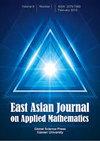论两种随机波动过程下的期权定价
IF 1.1
4区 数学
Q2 MATHEMATICS, APPLIED
引用次数: 0
摘要
从布莱克-斯科尔斯(Black-Scholes)期权定价模型出发,本研究评估了数学建模演变为双随机波动率模型的过程,研究了偏微分方程(PDE)方法的优化性能。本文重点研究了校准和数值方法过程,得出了赫斯顿模型和双赫斯顿模型的比较结果,从而设计出一种更有效的数值迭代分裂方法。通过李和黄的迭代分裂方法,数值结果得出结论:混合方法降低了整体计算成本,提高了迭代过程的收敛性,同时保持了 PDE 方法的简单性、灵活性和可解释性。本文章由计算机程序翻译,如有差异,请以英文原文为准。
On Pricing Options Under Two Stochastic Volatility Processes
From the Black-Scholes option pricing model, this work evaluates the evolution of the mathematical modelling into the double stochastic volatility model that
studies the optimization performance in partial differential equation (PDE) methods.
This paper focuses on the calibration and numerical methodology processes to derive
the comparison of the Heston and the double Heston models to design a more efficient
numerical iterative splitting method. Through Li and Huang’s iterative splitting method,
the numerical results conclude that the mixed method reduces the overall computational
cost and improves the convergence of the iterative process while maintaining the simplicity, flexibility and interpretability of PDE methods.
求助全文
通过发布文献求助,成功后即可免费获取论文全文。
去求助
来源期刊

East Asian Journal on Applied Mathematics
MATHEMATICS, APPLIED-
CiteScore
2.60
自引率
8.30%
发文量
48
期刊介绍:
The East Asian Journal on Applied Mathematics (EAJAM) aims at promoting study and research in Applied Mathematics in East Asia. It is the editorial policy of EAJAM to accept refereed papers in all active areas of Applied Mathematics and related Mathematical Sciences. Novel applications of Mathematics in real situations are especially welcome. Substantial survey papers on topics of exceptional interest will also be published occasionally.
 求助内容:
求助内容: 应助结果提醒方式:
应助结果提醒方式:


